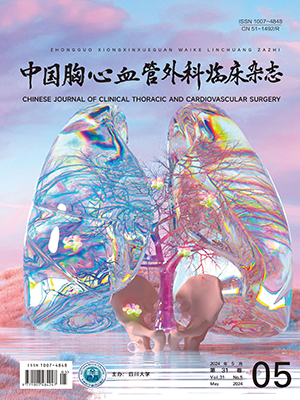| 1. |
Sung H, Ferlay J, Siegel RL, et al. Global cancer statistics 2020: GLOBOCAN estimates of incidence and mortality worldwide for 36 cancers in 185 countries. CA Cancer J Clin, 2021, 71(3): 209-249.
|
| 2. |
Shima T, Kinoshita T, Sasaki N, et al. Feasibility of intraoperative diagnosis of lung adenocarcinoma in situ to avoid excessive resection. J Thorac Dis, 2021, 13(3): 1338-1346.
|
| 3. |
陈金平, 周新成, 殷宪刚. 肺原发性良性黏液上皮性病变冷冻切片误诊为黏液腺癌12例分析. 临床与实验病理学杂志, 2019, 35(6): 705-706, 710.
|
| 4. |
姜格宁, 陈昶, 朱余明, 等. 上海市肺科医院磨玻璃结节早期肺腺癌的诊疗共识(第一版). 中国肺癌杂志, 2018, 21(3): 147-159.
|
| 5. |
NCCN Clinical Practice Guidelines Oncology. Non-small cell lung cancer. Version 1.2020. URL: https://www.nccn.org/patientresources/patient-resources/guidelines-for-patients. Accessed on 2022-06-30.
|
| 6. |
Susan CL, edit. Diagnostic Pathology: Intraoperative Consultation. Second edition. Elsevier, 2019. 240-246.
|
| 7. |
蒋汉文, 陈水莲, 张小鹰, 等. 甲状腺转录因子1免疫组织化学联合弹力纤维双重染色在肺腺癌诊断中的应用. 中华病理学杂志, 2021, 50(5): 514-517.
|
| 8. |
谢惠康, 查俊彦, 赵力澜, 等. 弹力纤维在肺腺泡型及乳头型为主腺癌中的表达及其与患者预后的相关性. 中华病理学杂志, 2016, 45(6): 375-380.
|
| 9. |
Travis WD, Brambilla E, Burke AP, et al. WHO classification of tumours of the lung, pleura, thymus and heart. https://publications.iarc.fr/Book-And-Report-Series/Who-Classification-Of-Tumours. Accessed on 2022-06-30.
|
| 10. |
WHO Classification of Tumours Editorial Board. WHO classification of tumours: Thoracic tumours. 5th Edition. https://publications.iarc.fr/595. Accessed on 2022-06-30.
|
| 11. |
Borczuk AC. Challenges of frozen section in thoracic pathology: Lepidic lesions, limited resections, and margins. Arch Pathol Lab Med. 2016.141(7): 932-939.
|
| 12. |
He P, Yao G, Guan Y, et al. Diagnosis of lung adenocarcinoma in situ and minimally invasive adenocarcinoma from intraoperative frozen sections: An analysis of 136 cases. J Clin Pathol, 2016, 69(12): 1076-1080.
|
| 13. |
Liu S, Wang R, Zhang Y, et al. Precise diagnosis of intraoperative frozen section is an effective method to guide resection strategy for peripheral small-sized lung adenocarcinoma. J Clin Oncol, 2016, 34(4): 307-313.
|
| 14. |
Luis HA, Zhou Y, Sihoe AD, et al. Survival is not compromised in patients with invasive adenocarcinoma found in GGOs receiving sublobar resection due to intraoperative frozen section ambiguity: A prospensity score matched analysis. 25th European Conference on General Thoracic Surgery, 2017.
|
| 15. |
Moreira AL, Ocampo PSS, Xia Y, et al. A grading system for invasive pulmonary adenocarcinoma: A proposal from the International Association for the Study of Lung Cancer Pathology Committee. J Thorac Oncol, 2020, 15(10): 1599-1610.
|
| 16. |
刘彤华. 诊断病理学今后应怎样发展. 诊断病理学杂志, 2003, 10(4): 193-194.
|
| 17. |
Butnor KJ. Avoiding underdiagnosis, overdiagnosis, and misdiagnosis of lung carcinoma. Arch Pathol Lab Med, 2008, 132(7): 1118-1132.
|
| 18. |
Trejo Bittar HE, Incharoen P, Althouse AD, et al. Accuracy of the IASLC/ATS/ERS histological subtyping of stageⅠlung adenocarcinoma on intraoperative frozen sections. Mod Pathol, 2015, 28(8): 1058-1063.
|
| 19. |
Chang JC, Montecalvo J, Borsu L, et al. Bronchiolar adenoma: Expansion of the concept of ciliated muconodular papillary tumors with proposal for revised terminology based on morphologic, immunophenotypic, and genomic analysis of 25 cases. Am J Surg Pathol, 2018, 42(8): 1010-1026.
|
| 20. |
Ishikawa Y. Ciliated muconodular papillary tumor of the peripheral lung: Benign or malignant? Pathol Clin Med (Byouri-to-Rinsho), 2002, 20: 964-965.
|
| 21. |
王恩华. 细支气管腺瘤: 易与癌混淆的良性肿瘤. 中华病理学杂志, 2019, 48(6): 425-432.
|
| 22. |
高何, 杜晓刘, 陈春妮, 等. 细支气管腺瘤15例临床病理学观察. 中华病理学杂志, 2020, 49(6): 556-561.
|
| 23. |
甘咏莉, 葛荣. 术中冰冻切片诊断肺部肿物427例分析. 实用肿瘤杂志, 2013, 28(3): 306-308.
|
| 24. |
Yang CH, Lee LY. Pulmonary sclerosing pneumocytoma remains a diagnostic challenge using frozen sections: A clinicopathological analysis of 59 cases. Histopathology, 2018, 72(3): 500-508.
|
| 25. |
沈元龙, 李琳, 吴子豪. 术中冰冻切片快速免疫组化HE染色技术诊断硬化性肺细胞瘤和肺腺癌的应用对比. 安徽医学, 2019, 40(12): 1392-1395.
|
| 26. |
刘加夫, 侯立坤, 武春燕. 肺硬化性血管瘤120例临床病理分析. 临床与实验病理学杂志, 2015, 31(2): 174-177.
|
| 27. |
韩国敬, 胡红, 毛丹, 等. IgG4相关性肺疾病八例临床特征分析. 中华结核和呼吸杂志, 2017, 40(3): 193-198.
|




